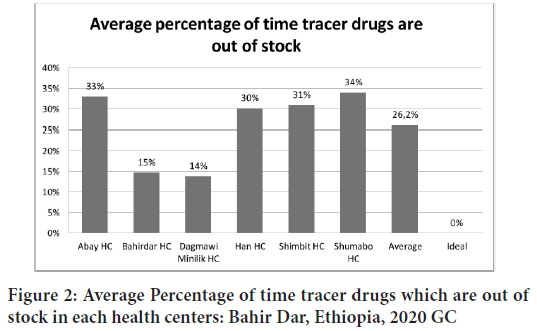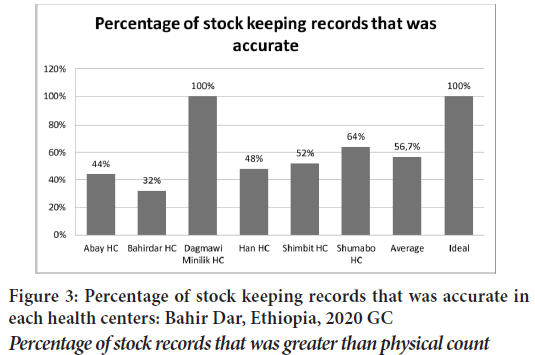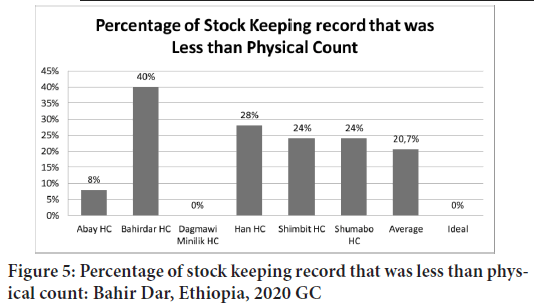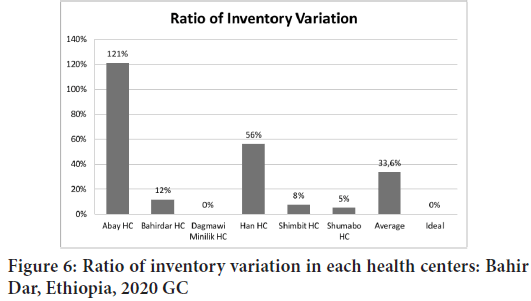Research Article - (2022) Volume 13, Issue 1
Availability of Essential Medicines and Inventory Management Practice at Public Health Centers in Bahirdar Town West Gojjam Zone, Amhara Region, Ethiopia, 2020
Kalkidan Worku Mitiku1*, Daniel Simeneh Mekonnen2 and Temesgen Ashagire3Abstract
Background: Essential medicines are medicines that satisfy the priority health care needs of the population. These medicines are selected with due regard to disease prevalence and public health relevance, evidence of clinical efficacy and safety, and comparative costs and cost-effectiveness. Essential medicines are intended to be available within the context of functioning health systems at all times in adequate amounts, in the appropriate dosage forms, with assured quality, and at a price the individual and the community can afford.
Objective: To assess availability of essential medicine and inventory management practice at public health centers in Bahir Dar town.
Method: Institutional based cross sectional study design conduct among six HCs in Bahir Dar town. Checklists were used according to Ems lists from the Amhara region health bureau to assess the availability of essential medicine. IMAT was used to review the essential drugs inventory records of tracer drugs and examine stock records and historical stock outs. An observational method was applied on physical stock of the inventory and the inventory record at the day of visit to check for stock availability, inventory accuracy, stock out durations and stock record variation.
Results: According to the study the average percent of time out of stock was 26.2%; the average percent of essential drugs available on the day of assessment was 74.7%. The average percentage of stock keeping records were accurate (56.7%), this study found that records were greater than physical counts (22.7%) and the average ratio of inventory variation to total stock was 33.7%.
Discussion and recommendation: The availability of Ems in Bahirdar public health centers was poor. Inaccurate stock keeping record was observed irrespective of health centers level. For increasing inventory management: Timely entries to logistic tool, updated records, updated stock status and when drugs are issued from the health facilities store room to different units, the date of issue and quantity issued being recorded on the available logistics tool were necessary.
Keywords
Essential medicines, Cross-sectional, Inventory management
Abbrevations
IMAT: Inventory Management Assessment Tool; LMIS: Logistics Management and Information System; PFSA: Pharmacutical Fund and Supply Agency; RRF: Report and Requwasition Form; STI: Sexual Transmited Infection; TDs: Tracer Drugs; WHO: World health organization
Introduction
Essential medicines are medicines that satisfy the priority health care needs of the population (WHO, 2004). These medicines are selected with due regard to disease prevalence and public health relevance, evidence of clinical efficacy and safety, and comparative costs and based on cost-effectiveness (WHO, 2002).
Essential medicines are intended to be available within the context of functioning health systems at all times in adequate amounts, in the appropriate dosage forms, with assured quality, and at a price the individual and the community can afford. About One third of world population doesn’t get access for essential medicines and majority almost half of the population in Africa and Asia doesn’t get access for essential medicine (Frerick B, et al., 2011). Based on the recommendations of WHO Ems should be available 100% (WHO, 1993). However, in Ethiopia it was found to be 91%. Researches emerged after 2009 implies that the availability of essential medicines in the country was varies from 26%-91% (FMHACA, 2010). Shortages of availability of essential medicines leads to divert people to private facilities which are high in costs and that may leads to therapeutic failure with majority of patients with low income and have to depend on the subsidized cost of healthcare promised in public facilities (WHO, 1993).
Pharmaceutical supply systems in many developing countries have severe problems on inventory management practice, including ineffective procedures in selection, poor quality control, and economically inefficient procurement. This has been documented in numerous reports and publications. For good pharmaceutical logistics system such as (selection, quantification, procurement and distribution) essential medicines are the major components, but if the logistic system doesn’t include good practice of Ems lead to failure of whole pharmaceutical management process (FMHACA, 2010; Drug Management Program, 1995).
For ensuring availability of Ems, good inventory management practice was needed. Inventory management was a good stock keeping practice that has accurate record keeping practice (United Nations Population Fund, 2012). Accurate and updated stock records helps for calculating future needs, and holding stocks was important to ensure availability of essential items almost all the time (Embrey MA, 2013).
Ethiopian Pharmaceutical Supply Agency (EPSA) undergoes researches on the assessment of inventory management practice in Ethiopia. Which indicates ware-house adequacy related challenges, demand information related problems and capacity building related challenges are the issue for poor inventory management process in Ethiopia. Poor inventory management in public health institutions results wastage of financial resources, poor availability of essential medicines, stock outs, and consequently, failure to improve patients’ health outcomes (IIfPHC, 2017).
The low availability of essential medicines and inventory management performance was the most problems of public sectors. Due to such reasons stock out can be occurred or happened in most of the time which was the main challenges for: the patients to get/take the medicines at the time they need and tends them in to other health problems either therapeutic failure, patient forced to purchase or bought drugs from the private pharmacies, patient loss their time and energy and also go to informal center or forgo treatment, and resistance or held them for death. There for this study aimed to assess the problem of essential drugs inventory management practice at public health centers found in Bahir Dar town, Amhara region. To provide a good insight for the current tracer drugs inventory management practice and drugs availability at health centers and to provide information about track changes and improvements in drugs availability and pharmaceutical inventory management practice over time.
Operational definitions
• Essential medicines: It is defined as “medicines that satisfy the priority health care needs of the population,” or it can be defined as medicines that need to be available in all times, with adequate amount, standard dosage forms and with fair coast in all health facility (WHO, 2004).
• Tracer drugs: Drugs listed by ministry of health of a country that should be available in all days and nights of the year (EPSA, 2017).
• Inventory management: Management system that involves ordering, receiving, storing, issuing and recording limited items based on the policy listed by the responsible body/ministry of health (Chuchu CJX, 2002).
• Availability of medicines: Available in the health facility during the time of visit (WHO, 1993).
• Stock out: The imbalance of the demand and the current inventory. Or it was unavailability of usable stocks in the store or a balance of zero on the bin cards at store (Odinga O, 2007).
Materials and Methods
Study area and study period
A cross sectional study was conducted from May 11, 2020 to May 18 2020, in Bahir Dar city. Bahirdar was the capital city of Amhara regional state, situated 578 Km from Addis Ababa (capital city of Ethiopia). The town was administratively structured by 06 sub cities and 17 KEBELES and has a total population of 356,757 of whom 168,839 are males and 187,918 females. The town has three government hospitals, 06 health centers, and six private hospitals.
Study design
A descriptive cross-sectional study complemented with a quantitative method was conducted.
Source of data
Helath centers found in Bahiradr city were the source population.
Data collection instrument and procedure
According to unpublished data of Amhara regional health bureau 25 drugs were identified as Essential medicines. Checklists were used according to Ems lists from the region to assess the availability of essential medicine. Inventory Management Assessment Tool (IMAT) was used to review the essential drugs inventory records of tracer drugs and examine stock records and historical stock outs. An observational method was applied on physical stock of the inventory and the inventory record at the day of visit to check for stock availability, inventory accuracy, stock out durations and stock record variation. For data collection procedure the following issues were addressed: Accuracy of stock record was collected by reviewing of store bin card and comparing it with the physical counts on the day of visit. Ratio of inventory variation to total stock was collected by reviewing the available stock level of products in the store and comparing it with difference on the recorded stock level of the product. Data on product availability was collected based on quantity of items on the store at the day of visit. Data on days out of stock was collected by quantifying number of days of each items was out of stock within the assessment period (the last 100 days).
Data analysis
A data collected by using forms and checklists were entered in to excel for further analysis of Essential medicine availability and to determine inventory management practice of health centers found in Bahirdar city. Stock out of tracer drugs was assessed based on average percentage of time that products were out of stock for the past 100 days and percentage of availability of products in stock was based on the stock available on the day of the assessment.
The following measurements that used for analysis of inventory management were adopted from (WHO, 2012).
Percentage of products in stock: It Measures the system's effectiveness in maintaining a range of products in stock (at the time of the assessment) calculated by-
The total products in stock/Total number of products in the study × 100
Then, the average percentage of products available on the day of visit for the facility sample was obtained as follows:
Sum% of products in stock on the day of assessment for each facility/Total number of facilities in the sample × 100
Average percentage of time that products are out of stock: It Indicates the system's capacity to maintain a constant supply of products over time by minimizing the duration of stock outs. It was assessed based on average percentage of time that products were out of stock for the past 100 days.
Total number of days out of stock within the last 100 days/Total number of products in the study × 100 days × 100
Then after, the average percent of time out of stock of the tracer products for the facility sample was obtained using the following formula-
Sum of average% of time that products were out of stock for each facility/ Total number of facilities in the sample × 100
Percentage of stock records that was accurate: It Indicates the quality of the record-keeping system by identifying the proportion of records that was accurate. The first step was to obtain facility specific percentage of stock records of tracer drugs that was accurate corresponding with physical counts was obtained, using the following formula-
Count of records that are accurate/Total number of products in the study × 100
Thereafter, the average percent of stock records that was accurate for the tracer products for the facility sample was obtained using the following formula
Sum of average% for each facility/Total number of facilities in the sample × 100
Ratio of inventory variation to total stock: It indicates the severity of record-keeping errors. First, facility specific ratio of inventory variation to total stock was obtained as follows
Total sum of absolute value of the difference between recorded and physical values/The total sum of Physical quantity (based on actual count) × 100
Then, the average ratio of inventory variation to total stock for the facility sample was obtained as follows
Sum of average ratio of inventory variation for each facility/Total number of facilities in the sample × 100
Data quality assurance
In order to check for data collection tool completeness, accuracy, clarity and consistency pre-test was done in Zenzelma health center. Trainings for two days were obtained for data collectors which were 3rd year pharmacy students.
Ethical consideration
Ethical approval was obtained from the Ethics and research Committee of GAMBY medical and business College. The aim of the study and the way it was going to be conducted was explained to the head of pharmacy unit and pharmacists of each health centers.
Dissemination of the result
At the end of the study, Findings of the study was communicated to stack holders, and will be presented on scientific meetings and conferences as well it will submit for publication on scientific journals.
Results
Availability of tracer drugs
In ideal situation we expect 100% of tracer drugs to be available in all health centers at all time (Frerick B, et al., 2011). However, availability of essential medicines among health centers in Bahirdar was found to be 74.7%. The highest percentage of tracer drugs availability was observed in Bahir Dar health center which was 84% (Figure 1).
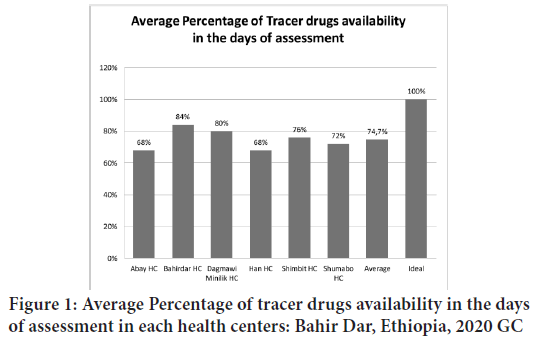
Figure 1: Average Percentage of tracer drugs availability in the days of assessment in each health centers: Bahir Dar, Ethiopia, 2020 GC
The average percentage of time that tracer drugs that are out of stock
In ideal situation, stock out rate was expected to be 0% within all visited time. The average stock out rate of EMs in Bahirdar city health centers was 26.2%. From the result, Shumabo health center have the highest stock out rate which was 34% and Dagmawi Minilik health center had the lowest stock out rate (14%) (Figure 2).
Figure 2: Average Percentage of time tracer drugs which are out of stock in each health centers: Bahir Dar, Ethiopia, 2020 GC
Accurate stock records
According to the result the average percentage of accurate stock record keeping practice was 56.7%. Dagmawi Minilik health center had a clear accurate recording of stocks than other health facilities (100%). On the other hand Bahir Dar, Abay and Han health centers had poor record keeping practice (32%, 44% and 48% respectively) (Figure 3).
Figure 3: Percentage of stock keeping records that was accurate in each health centers: Bahir Dar, Ethiopia, 2020 GC
The percentage of stock records that was greater than the physical count was 22.7%, which was far from the ideal record system (0%). Abay health center and Han health center had 24% and 48% (respectively) of stock records that was greater than the physical count. However, Dagmawi Minilik had performed ideal record system of the lowest value which was 0% (Figure 4).
Figure 4: Percentage of stock keeping record that was greater than physical count: Bahir Dar, Ethiopia, 2020 GC
Percentage of stock keeping records that was less than physical count of the stock
The percentage of stock keeping records that was less than the physical count of the stock had an average of 18%. This was interpreted as 18% of records were less than where available in shelves. Even though, the ideal value for this indicator was 0%. In Bahir Dar health center percentage of stock keeping records that was less than the physical count of the stock was 40% which was highest than other health centers and Dagmawi Minilik health center had 0% records available in the shelves (Figure 5).
Figure 5: Percentage of stock keeping record that was less than physical count: Bahir Dar, Ethiopia, 2020 GC
Inventory variation to total stock
According to this study the average ratio of inventory variation to total stock was 33.7%. Among health centers Abay health center had the highest score which was 121% and Dagmawi Minilik health center had the lowest value which was 0% (Figure 6).
Figure 6: Ratio of inventory variation in each health centers: Bahir Dar, Ethiopia, 2020 GC
Discussion
In Ethiopia, there are frequent drug shortages in public health facilities; a national survey estimates that only 70% of essential medicines were available in the public sector (Cameron A, et al., 2008). Similarly in this research the availability of essential medicines were on average of 74.7% during the day of visit.
This finding was higher when compared with a study conducted in health centers of south Western Ethiopia showed that only 55.6% of essential drugs were available (IIFHPC, 2017). This might be due to budget utilization of health facilities, quality of PFSA, and due to the data collection procedures because this study uses WHO checklist technique.
However the result was lower when compared to Ghana, Tanzania and Kenya the availability of Essential Drugs was 80%, 88.9% and 82.6%, respectively (Narkotey AM, 2012; Frerick B, et al., 2011; Chuchu CJX, 2002). This may be as a result of PFSA quality of each country, demographic variations, economic status difference between each country, and might be due to budget utilization of each country across the continent.
Stoke out days
This study found that all facilities had experienced stock out of a number of products in the past 100 days and all had stock outs of a number of products on the day of assessment.
Stock outing of EMs at the day of surveys in Bahir Dar city health centers was 26.2% which was higher than previous studies in Tanzania 20%, south wollo zone 14% and Gondar Ethiopia 9% and (Frerick B, et al., 2011; Mahammed T, 2018; Fentie M, et al., 2015). This might me due to good stock record technique, and awareness of which drugs are essential in the community.
Stoke record accuracy
Accuracy of stock records was very critical for proper inventory management. According to the study 56.7% of the records were accurate records. As the data indicates on average of 43.3% of stock records were inappropriate This might be due to lack of knowledge about appropriate stock record practice or it might be due to lack of trainings on how to perform accurate stock records. This finding was lower when compared with a study done in south wollo which was 62%. This could be as a result of accurate consumption data are not available, and poor knowledge of stoke keeper.
The recorded balances that were greater than the physical counts were 22.7%. Which indicates the recording of supplies in Bahirdar health centers was very poor. Recorded balances that were less than the physical counts were 20.7%; this means that receipts were not correctly recorded. The average percentage of total variation between stock records and physical counts for the tracer products was 43.4%, which was relatively higher compared to a study done in south wollo which was 39% (Fentie M, et al., 2015). The difference might be due to knowledge of stock keepers, lack of software applications and budget sufficient of health centers.
Ratio of inventory variations
According to This study the ratio of inventory variation was 33.7%. This was significantly higher when compared to ratio of international variation which was 21%. The study done in Afghanistan found that 20% to 25% of the warehouses did not have up to date stock cards, did not mark dates of stock outs and did not keep the stock card with the items (USAID 2006). This difference might be due to recording status of the facility, and it might be also due to the variation on assessment of the progress.
Conclusion
Availability of essential medicine in Bahirdar city health centers was inadequate. Inaccurate record keeping practice was high in all health facility despite of the facility level/facility volume. The practice of updating record in the logic system tool was also the problem. In addition, Ratio of inventory variation to total stock was higher.
Recommendation
Frequent checkup of stock status should be made by responsible bodies, and numbers of professionals who works at pharmacy should be increased to reduce workload and to practice accurate and updated record keeping practice were advisable to have good inventory practice and availability of essential medicines. Logistic tools should update stock status and when drugs are issued from the health facilities store room to different units, the date of issue and quantity issued have to be recorded on the available logistics tools. The government should monitor the record keeping practice.
Limitation of the Study
• The data collection does not include its special zone health centers.
• In health centers like Bahirdar health center computers were not functional and improper use of bin card was observed.
References
- The World Health Report. Equitable access to Essential Medicines: A Framework for Collective Action. World Health Organization (WHO). 2004.
- Equitable access to Essential Medicines: A Framework for Collective Action. World Health Organization (WHO). 2004.
- The World Health Report. Reducing Risks, Promotion Healthy Life. World Health Organization. 2002.
- WHO. How to Investigate Drug Use in Health Facilities: Selected Drug Use Indicators. World Health Organization. 1993.
- WHO. List of Essential Medicines for Ethiopia. Food, Medicine and Healthcare Adminwastration and Control Authority of Ethiopia (FMHACA). World Health Organization. 2010.
- MSH. Rapid Pharmaceutical Management Assessment: An Indicator-Based Approach. USA. Drug Management Program. 1995.
- UNFPA. UN Commission on Life-Saving Commodities for Women and Children. Commissioners’ Report. United Nations Population Fund. 2012.
- Frerick B, Kuper M, Tiba MR. Availability and Management of Medicines and Medical Supplies: Findings from an Assessment of 87 Health Facilities in Four Regions in Tanzania. Tanzanian German Programme to Support Health (TGPSH). 2011.
- IIfPHC. Ethiopia Service Availability and Readiness Assessment 2016 Summary Report. Ethiopian Public Health Institute (IIfPHC). 2017.
- The Ethiopian Pharmaceuticals Supply Chain Management System Monitoring and Evaluation Training Participant Manual. EPSA. 2017.
- Chuchu CJX. Corruption-the Main Cause of the Premature End of Taiping Tianguo. Jinhua College of Profession and Technology. 2002.
- Odinga O. Drug Management and Rational Use. The African Medical and Research Foundation (AMREF). 2007.
- WHO. Pharmaceutical Management for Health Facilities. World Health Organization. 2012.
- Cameron A, Ewen M, Degnan DR, Ball D, Laing R. Medicine Prices, Availability, and Affordability in 36 Developing and Middle-Income Countries: A Secondary Analysis. World Health Organization (WHO). 2008.
- IIFHPC. Ethiopia Service Availability and Readiness Assessment 2016 Summary Report. International Institute for Primary Health Care in Ethiopia (IIFHPC). 2017.
- How to Investigate Drug Use in Health Facilities: Selected Drug Use Indicators. World Health Organization. 1993.
- Mahammed T. Pharmaceutical inventory management performance: South wollo Ethiopia. Adwas Ababa University. 2018: 36-43.
- List of Essential Medicines for Ethiopia. Food, Medicine and Healthcare Adminwastration and Control Authority of Ethiopia (FMHACA). World Health Organization. 2010
- USAID. Assessment of the pharmaceutical logwastics management capacity of REACH Grantee NGOs in Afghanwastan. 2006.
Author Info
Kalkidan Worku Mitiku1*, Daniel Simeneh Mekonnen2 and Temesgen Ashagire32Department of Pharmacy, GAMBY Medical and Business College, Bahir Dar, Ethiopia
3Department of Pharmacy, AFILAS General Hospital, Bahir Dar, Ethiopia
Citation: Mitiku KW: Availability of Essential Medicines and Inventory Management Practice at Public Health Centers in Bahirdar Town West Gojjam Zone, Amhara Region, Ethiopia, 2020
Received: 15-Dec-2021 Accepted: 29-Dec-2021 Published: 05-Jan-2022, DOI: 10.31858/0975-8453.13.1.12-16
Copyright: This is an open access article distributed under the terms of the Creative Commons Attribution License, which permits unrestricted use, distribution, and reproduction in any medium, provided the original work is properly cited.
ARTICLE TOOLS
- Dental Development between Assisted Reproductive Therapy (Art) and Natural Conceived Children: A Comparative Pilot Study Norzaiti Mohd Kenali, Naimah Hasanah Mohd Fathil, Norbasyirah Bohari, Ahmad Faisal Ismail, Roszaman Ramli SRP. 2020; 11(1): 01-06 » doi: 10.5530/srp.2020.1.01
- Psychometric properties of the World Health Organization Quality of life instrument, short form: Validity in the Vietnamese healthcare context Trung Quang Vo*, Bao Tran Thuy Tran, Ngan Thuy Nguyen, Tram ThiHuyen Nguyen, Thuy Phan Chung Tran SRP. 2020; 11(1): 14-22 » doi: 10.5530/srp.2019.1.3
- A Review of Pharmacoeconomics: the key to “Healthcare for All” Hasamnis AA, Patil SS, Shaik Imam, Narendiran K SRP. 2019; 10(1): s40-s42 » doi: 10.5530/srp.2019.1s.21
- Deuterium Depleted Water as an Adjuvant in Treatment of Cancer Anton Syroeshkin, Olga Levitskaya, Elena Uspenskaya, Tatiana Pleteneva, Daria Romaykina, Daria Ermakova SRP. 2019; 10(1): 112-117 » doi: 10.5530/srp.2019.1.19
- Dental Development between Assisted Reproductive Therapy (Art) and Natural Conceived Children: A Comparative Pilot Study Norzaiti Mohd Kenali, Naimah Hasanah Mohd Fathil, Norbasyirah Bohari, Ahmad Faisal Ismail, Roszaman Ramli SRP. 2020; 11(1): 01-06 » doi: 10.5530/srp.2020.1.01
- Manilkara zapota (L.) Royen Fruit Peel: A Phytochemical and Pharmacological Review Karle Pravin P, Dhawale Shashikant C SRP. 2019; 10(1): 11-14 » doi: 0.5530/srp.2019.1.2
- Pharmacognostic and Phytopharmacological Overview on Bombax ceiba Pankaj Haribhau Chaudhary, Mukund Ganeshrao Tawar SRP. 2019; 10(1): 20-25 » doi: 10.5530/srp.2019.1.4
- A Review of Pharmacoeconomics: the key to “Healthcare for All” Hasamnis AA, Patil SS, Shaik Imam, Narendiran K SRP. 2019; 10(1): s40-s42 » doi: 10.5530/srp.2019.1s.21
- A Prospective Review on Phyto-Pharmacological Aspects of Andrographis paniculata Govindraj Akilandeswari, Arumugam Vijaya Anand, Palanisamy Sampathkumar, Puthamohan Vinayaga Moorthi, Basavaraju Preethi SRP. 2019; 10(1): 15-19 » doi: 10.5530/srp.2019.1.3







